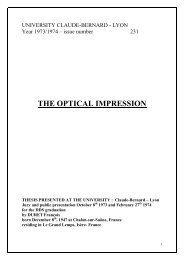english version(pg40to78) - Pr. François Duret
english version(pg40to78) - Pr. François Duret
english version(pg40to78) - Pr. François Duret
Create successful ePaper yourself
Turn your PDF publications into a flip-book with our unique Google optimized e-Paper software.
F <strong>Duret</strong> and Coll. <strong>Pr</strong>incipes de fonctionnement et applications techniques de l’empreinte optique dans l’exercice de cabinet<br />
(traduction Anglaise)<br />
Page 103<br />
[Fig 39: comparison of manufacturing of a micro-drill and the<br />
sculpture of crowns]<br />
MATERIALS<br />
The realisation of a prosthetic piece necessarily needs successive<br />
mouldings and in the most majority of cases, lost wax process. We<br />
will not mention the multiple “inevitable” errors inherent to the<br />
manufacturing process, and focus on the problem of the dental<br />
biomaterial as it exists currently, for conjoined prosthesis (Fig 40 and<br />
41).<br />
In the majority of cases, we use:<br />
- casting metals, covered or not in ceramics or compound resins<br />
- and in a future we hope to be close, amorphous casting glass and<br />
“ceramised” later by thermal treatment. But in every case the<br />
material will be casted or moulded in our laboratories with<br />
limited performances if we compare them to those of the same<br />
type from industrial laboratories. This manufacturing mode of<br />
our prosthetic pieces presents in our opinion 2 major<br />
disadvantages:<br />
1) it rejects any material which won’t cast or be moulded with the<br />
technological means of our laboratories. Thus are rejected a<br />
number of biocompatible substances for the simple and unique<br />
reason that our “home-made” technology doesn’t let us work on<br />
them.<br />
2) It requires:<br />
- heavier and heavier technical material<br />
- more and more qualified labor<br />
- a manufacturing time that always increases with new clinical<br />
needs which are legitimate.<br />
Les Cahiers de <strong>Pr</strong>othèse (50) pp 73 – 110, 1985



